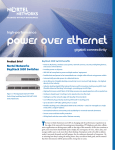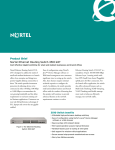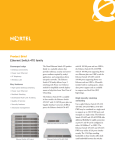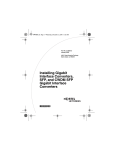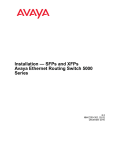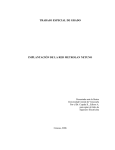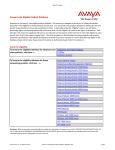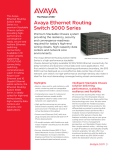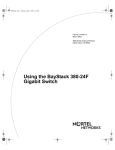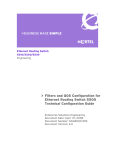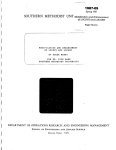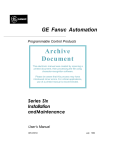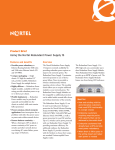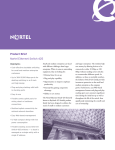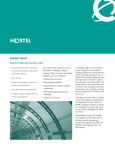Download Nortel Ethernet Routing Switch 5530-24TFD
Transcript
>THIS IS THE WAY TO IMPROVE APPLICATION PERFORMANCE >THIS IS Product Brief Nortel Ethernet Routing Switch 5530-24TFD Benefits > Higher flexibility of deployment using high-density Gigabit copper or fiber connection — up to 192 10/100/1000 ports or 96 SFP ports in a stack > Exceptional uplink performance utilizing dual 10-Gigabit ports — up to sixteen 10-Gigabit ports in a stack > Flexible stacking across Ethernet Routing Switches 5510, 5520 and 5530 — stack is managed as a single entity with a single IP address > Easy to configure using the USB interface > Optimized intra-stack performance — with stacking bandwidth up to 640 Gbps > Wire-speed operation with 160 Gbps switch fabric > Minimal network downtime using resilient connectivity, fail-safe stacking and power redundancy > Hardware-based Layer 3 routing at wire-speed > Intelligence at the network edge with Quality of Service (QoS) > Cost-effective plug-and-play stacking with built-in stacking ports > Secure access and data traffic protection The way in which businesses use LANs is changing and the performance requirement at the edge of the network is becoming more demanding. IP Telephony and other collaborative applications are driving more traffic to the edge of the network. As file sizes continue to grow, users need more bandwidth. Quite simply, the convergence of voice, video, data and storage enables users to do more from their desktop. Time delay-sensitive applications benefit from higher bursting capabilities; therefore, end users’ quality of experience (QoE) is improved by deploying Gigabit desktop switches. As more Gigabit desktops are deployed, the need for faster uplink is also impacted, driving the need for multiple Gigabits links trunked together or 10Gigabit technology. Enterprises need to be able to address today’s increased demands and still prepare for the unknown demands of tomorrow. By reassessing how they’re using the wiring closet, they can achieve both goals, and be assured that their investments will be protected for a long time to come. A new addition to the Nortel Ethernet Routing Switch 5000 Series, the Nortel Ethernet Routing Switch 5530-24TFD is a next-generation stackable 10/100/ 1000/10000 Mbps Ethernet Layer 3 routing switch designed to provide high-density Gigabit desktop connectivity and Gigabit and 10-Gigabit fiber connectivity for aggregation for midsize and large enterprise customers’ wiring closets. The Ethernet Routing Switch 5530 combines higher flexibility of deployment using Gigabit copper or fiber connections coupled with exceptional performance utilizing dual 10-Gigabit uplinks. The Ethernet Routing Switch 5530 is a scalable and resilient solution that provides exceptional security features and support for enhanced convergence while minimizing capital and operational expenses. Figure 1. Ethernet Routing Switch 5530-24TFD and stack of 5510, 5520 and 5530 Switches. 2 The Ethernet Routing Switch 553024TFD provides 24 10/100/1000 BASE-T RJ-45 ports, 12 shared Small Form-factor Pluggable (SFP) slots, and 2 slots for 10-Gigabit Ethernet Small Form-factor Pluggable (XFP) modules. The switch includes two built-in stacking ports in a compact one rackunit high design. The Ethernet Routing Switch 5530-24TFD may be utilized in standalone mode, or may be stacked together in a mixed stack of eight units with existing Ethernet Routing Switch 5510-24T/48T or 5520-24T/48TPWR devices. High-density Gigabit desktop switching switches such as the Ethernet Routing Switch 8600 (formerly known as Passport 8600). Using the proven Distributed Multi-Link Trunking (DMLT) resiliency feature, up to 16 10-Gigabit XFP ports are available for uplink connectivity in a full stack — among the highest in the market. The higher uplink performance optimizes the Gigabit data traffic from wiring closets to the network core and improves business productivity. The 10-Gigabit ports can also be used for 10-Gigabit server connections. IEEE 802.3ae-compliant 10GBASE-LR, 10GBASE-ER and 10GBASE-SR interfaces are supported. The Ethernet Routing Switch 5530 provides up to 24 10/100/1000BASE-T RJ-45 ports. As many as eight Ethernet Routing Switch 5510, 5520 and 5530 models can be stacked to achieve up to 384 10/100/1000 ports for high-density Gigabit desktop switching. The Ethernet Routing Switch 5530 can also be used for server aggregation. Switch fabric architecture offering non-blocking wirespeed performance High-density Gigabit fiber switching The Ethernet Routing Switch 5530 architecture supports wire-speed Layer 3 IP routing with static and local route support. The Ethernet Routing Switch 5530 supports high-performance wirespeed IP routing between VLANs. IP routing with static routes at the edge improves the network performance as the packets do not have to go to the core and the routing takes place within the switch or stack. The Ethernet Routing Switch 5530 includes 12 SFP (Gigabit fiber) ports that are shared with 12 10/100/1000 ports, making it an ideal solution for aggregation of wiring closet switches. Up to eight Ethernet Routing Switch 5530s models can be stacked to achieve up to 96 SFP ports for high-density Gigabit fiber connection. The Ethernet Routing Switch 5530 can also be used for server aggregation for servers with fiber NICs. IEEE 802.3z-compliant 1000BASE-SX, 1000BASE-LX and 1000BASE-CWDM physical interface support provides flexibility in switch deployment. The Ethernet Routing Switch 5530 has a high-performance Layer 3 switching fabric with a maximum of 160 Gbps forwarding bandwidth and wire-speed performance. Layer 3 IP routing Up to 16 10-Gigabit uplink ports in a stack The Ethernet Routing Switch 5530 supports the DHCP (Dynamic Host Configuration Protocol) Relay feature providing the system with the ability to relay DHCP requests to the DHCP server and eliminates the need for a DHCP server on every subnet. It forwards a request for an IP address from a client to a DHCP server across subnets. The Ethernet Routing Switch 5530 has dual built-in 10 Gigabit uplink ports — ports 25 and 26 — for dedicated uplink connectivity to network core Software feature enhancements are planned to include support for routing protocols such as Routing Information Protocol (RIP v1/v2), OSPF and VRRP.† This design supports an optimal data flow across the stack using a shortest path algorithm. Most vendors today employ a traditional ring architecture, meaning that a packet travels on the ring in only one direction. For example, in a stack of eight switches, if a packet needs to go from unit 2 to unit 3, it can get there in a single hop. But if a packet needs to go from unit 3 to unit 2, then it has to traverse from 3 to 4, 4 to 5, 5 to 6, and so on until it reaches unit 2. This requires seven hops. Nortel’s FAST stack design uses the shortest past algorithm, which means that the packet would traverse directly from unit 3 to unit 2 in a single hop. Plug-and-play stacking with built-in stacking ports The Ethernet Routing Switch 5530 has built-in stacking ports for faster, plugand-play stacking. This is more costeffective as cascade modules are not required. This stacking design frees up both of the uplink ports for dedicated connectivity to the backbone or highspeed servers. The Ethernet Routing Switch 5530 is shipped with a cascade cable (1.5 feet). In addition, cascade cables are also available in different lengths — 1.5 feet, 10 feet and 5 meters (16.4 feet) — to cover a variety of stacking needs. 80 Gbps 80 Gbps 80 Gbps 80 Gbps 40 Gbps 40 Gbps 80 Gbps As shown here, a unit can simultaneously have traffic flow to each adjacent unit at 40 Gbps full duplex. 40 Gbps 80 Gbps 640 Gbps Max stacking bandwidth for the stack Upstream traffic 40 Gbps Nortel’s innovative FAST (Flexible Advanced Stacking Technology) stacking design of the Ethernet Routing Switch 5000 Series allows for simultaneous bidirectional traffic flow on each stacking port (Figure 2). In a full stack, this design yields up to 640 Gbps stacking bandwidth. 40 Gbps 80 Gbps Innovative FAST stacking design 40 Gbps 80 Gbps 40 Gbps Figure 2. Innovative FAST stacking architecture 40 Gbps The Ethernet Routing Switch 5530 is offered in a compact one-rack unit high design that results in significant space and cost savings in the wiring closet. 40 Gbps Compact form factor 40 80 Gbps stacking bandwidth per switch 40 Gb Gb ps ps Downstream traffic Recessed connectors Nortel support site for all Ethernet Routing Switch 5000 types. The image needs to be loaded only to the base unit of the stack which automatically loads it to other switches in the stack. Figure 3. Plug-and-play stacking with recessed stack connectors Recessed stacking connectors for higher reliability The Ethernet Routing Switch 5530 is designed with recessed stacking connectors that save premium closet space and protect the integrity of the stack from accidental contact (Figure 3). Ethernet Switch Software The Ethernet Switch Software for the Ethernet Routing Switch 5000 Series is a single software image that allows the 5510, 5520 and Ethernet Routing Switch 5530s to stack together. The Ethernet Switch Software simplifies network operations by reducing the number of steps required for switch software updates. Only a single image needs to be downloaded from the Ethernet Switch Software features Newly released software is downloadable from the Web and supports the following new major features: • Auto Unit Replacement • New Unit Quick Configuration • IP Flow Information Export (IPFIX) • Multiple Spanning Tree Protocol (MSTP) over MLT • Domain Naming Services (DNS) • Per Port BaySecure • Dual Configuration • Many to 1 Port Mirroring • IP Directed Broadcast • Port-based Quality of Service Policy Support • Security Wizard 3 Auto Unit replacement feature Per Port BaySecure In the unlikely event that a switch fails in a stack, the affected switch can easily be replaced without service interruption. This feature allows the administrator of a switch stack to quickly replace a switch that has failed in the stack. With Auto Unit Replacement, when a switch fails in a stack configuration, the failed switch is removed from the stack and the replacement switch is automatically updated with most of the failed switch’s configuration. This security feature will enable the administrator to authorize a number of MAC addresses that will be allowed to use a specific port. These MAC addresses will in turn be added to the MAC Security Address Table until they reach their age out limit of 65535 minutes and are deleted. New Unit Quick Configuration This feature provides the capability to automatically apply default parameters to all the ports of a switch when it is added to a stack or when a switch is added to a standalone switch to create a stack. These default parameters include VLAN ID, Port Speed, Duplex Settings, PVID and Spanning Tree Groups. IP Flow Information Export (IPFIX) This feature will allow IP traffic to be sampled and classified into different flows based on certain parameters such as IP protocol, destination IP address and source IP address. This information will be collected by the switch. In a future release of software there will be a process to export this information to a collector device which will assist in interpreting the data. MSTP over MLT The MSTP over MLT feature will add the capability for ports participating in a Multi-Link Trunk to be in different Spanning Tree Groups. This feature allows Multiple STGs to exist on the MLT ports. Domain Naming Services (DNS) Domain Naming Services (DNS) enhancements in Software Release 4.2 will add new name resolution services that will allow for the querying of up to three DNS servers at a time for redundant name look-up. 4 Dual Configuration This feature will allow the storage of more than one configuration file in the flash memory of the switch or stack. This will allow the switch administrator to choose the switch or stack configuration to use when booting. Many to 1 Port Mirroring This feature will allow mirroring of multiple ports to a single monitoring port. The user will be able to select the monitor port, the mirrored ports and the type of mirrored traffic. IP Directed Broadcast This feature will allow the switch to take an incoming unicast frame and determine if it is a directed broadcast for one of its interfaces. If so, it will then forward the datagram onto the appropriate network using a link-layer broadcast. Port-based Quality of Service Policy Support This feature allows users to assign ports to QoS Policies. Multi-Link Trunking Multi-Link Trunking (MLT) enables grouping of links between the Ethernet Routing Switch 5510 and another switch or server to provide greater bandwidth with active redundant links. Nortel’s unique Distributed Multi-Link Trunking (DMLT) feature allows trunked ports to span multiple units of the stack for fail-safe connectivity to mission-critical servers and the network center (Figure 4). The Ethernet Routing Switch 5530 supports up to six trunks per switch or stack, with each trunk consisting of up to four members and providing up to 16-Gbps bandwidth per trunk using Gigabit ports. The Split Multi-Link Trunking (SMLT) feature of Ethernet Routing Switch 8600 eliminates single points of failure in the network and allows wiring closet switches, such as the Ethernet Routing Switch 5530, to have multiple active connections to the network core (Figure 4). All links from a distributed multi-link trunk can be active simultaneously. This allows customers to load-balance their network, double the bandwidth and use all the ports they have paid for. By combining the reliability of the Ethernet Routing Switch 8600 with the Ethernet Routing Switch 5530’s resilient trunking features — including DMLT, MLT and bi-directional FAST stacking, Nortel has created the next generation of flexible networking solutions. The Ethernet Routing Switch 5530 is architected to support SMLT and Inter Switch Trunk (IST) in the future†. IEEE 802.3ad Link Aggregation IEEE 802.3ad provides an industrystandard method for bundling multiple links together to form a single trunk between two networking devices. Both Dynamic Link Aggregation Group (LAG) trunks and MLT trunks with up to six LAG or MLT groups are supported. Once configured, the Link Aggregation Group (LAG) or trunk group is managed by the Link Aggregation Control Protocol (LACP). Link Aggregation allows more than four links to be configured in one LAG. The first four high priority links will be active links and the lower priority link will be a standby link. When one of the active links goes down, a standby link will become active. Figure 4. Enterprise solution Gigabit links 10/100 connections Aggregation 5510 Stack Distributed Multi-Link Trunks 470 Switch stack Desktop users 10 Gigabit links 5530 Stack Split Multi-Link Trunks All ports active 10/100/1000 connections 8600 Switch 8600 Switch Inter Switch Trunk Distributed Multi-Link Trunks Desktop users Integrated Time Domain Reflectometer (TDR)† For advanced resiliency, the Ethernet Routing Switch 5530 is architected to include an integrated TDR. This feature will simplify troubleshooting of the physical cable plant, enabling IT managers to quickly identify the failing mechanism and isolate to the source of the problem, helping ensure maximum uptime of the network. Through remote and non-invasive diagnosis of cabling issues such as cable opens, cable shorts or impedance mismatch in the cable and report, within one meter, the distance of the fault. The switch can detect and report these issues without unplugging cables and plugging in expensive cable testers. (Feature supported with future software release.) Servers that can accommodate up to three 600-Watt RPS modules. Each 600-watt module can power an Ethernet Routing Switch 5530. In the unlikely event the power supply in the switch fails, the RPS 15 will keep supplying power without requiring a device reboot. During normal operation, the RPS load shares with the power supply in the network device, thereby increasing the life expectancy of the power supply. IPv6 filtering and classification support for future applications The Ethernet Routing Switch 5530 is able to identify, prioritize, classify and redirect IPv6 traffic to a router. These switches can address the need for larger addressing and tighter security as the networks grow. Redundant power Jumbo frame support for larger file applications Redundant Power Supply support can be provided using Ethernet Routing Switch RPS 15. The RPS 15 Power Supply Solution consists of a chassis Jumbo frame support of up to 9,216 bytes is provided on each port for applications requiring large frames such as graphics and video applications. Servers Universal Serial Bus (USB) Ports The Ethernet Routing Switch 5530 features USB ports on the front panel adjacent to the console port and on the back panel. The addition of USB ports will enable switch administrators to perform tasks that were previously completed through TFTP with a commonly available USB Mass Storage Device (“flash drive” or “thumb drive”). These tasks include Software Download, ASCII Configuration File Generation and Download and Syslog Copying. Quality of Service (QoS) The QoS features of the Ethernet Routing Switch 5530 allow users to not only utilize bandwidth more efficiently, optimizing existing network resources and capabilities, but also provide packet classification and marking at the edge of the network, simplifying the QoS deployment at the aggregation and core of the network. By classifying, prioritizing, policing and marking LAN traffic (based on DiffServ, Code 5 Point and 802.1p), networks can offer reliable connectivity and required bandwidth for mission-critical applications, such as IP Telephony, to specific groups, users and individual devices. For each of these applications, advanced QoS features support Internet Engineering Task Force (IETF), the standard DiffServ QoS architecture — a packet classification based on the content of IP packet header fields (voice, video, data) — as well as traffic policing. QoS and policy management DiffServ QoS enables networks to read, alter, prioritize, tag or mark IP packets based upon information embedded in the Type of Service (ToS) field. The level of service can be marked in the embedded information inside the ToS field of each IP packet. DiffServ is based on the ToS field. The Ethernet Routing Switch 5530 has applicationspecific integrated circuits (ASICs) to enable the DiffServ Code Point (DSCP) to be mapped to the IEEE 802.1p user priority bits to provide consistent QoS at Layer 3 (IP) and Layer 2 (Ethernet). The QoS policies can be configured via the switch’s builtin Web-based management tools to facilitate QoS. Alternatively, Enterprise Policy Manager (formerly Optivity Policy Services) can be utilized for dynamic end-to-end enterprise-wide policy and QoS management. Simplified QoS The Ethernet Routing Switch 5530 supports Nortel Service Classes (NSC), which provide simplified QoS provisioning. NSC provides factory-default QoS configurations, eliminating the complexities often associated with QoS-enabled network deployments. NSC provides default settings such as: • DSCP marking per class • DiffServ forwarding behavior (PHB) per class • DSCP to queue mapping • DSCP to 802.1p mapping • Default scheduler per class 6 By classifying the traffic and placing it into an NSC, complex QoS configurations are eliminated. NSC simplifies the deployment of a QoS-enabled network with Nortel switching solutions, using a Web-based interface. This not only saves on provisioning time but most importantly, ensures that the QoS functions are provisioned consistently across the network. Queuing function The Ethernet Routing Switch 5530 provides network availability for mission-critical applications, devices and users by classifying, prioritizing and marking LAN IP traffic using up to eight hardware-based queues on every port including the stacking ports. This is based on the following parameters: Further benefits include: • Simple intuitive policy creation • Ability to re-use common filter sets • Provision of a network-wide view of policies currently in use • Ability to avoid QoS provisioning errors • Centrally managed DSCP and 802.1p queue mapping tables • Saved time in provisioning the network — as thousands of CLI or Web transactions are reduced to a few simple actions Traffic policing • IP Protocol ID (e.g., TCP, UDP, IGMP) Traffic policing enables provisioning of different levels of service by limiting traffic throughput at the ingress (incoming) port of the Ethernet Routing Switch 5530. For example, if a port is set to a certain speed, such as 10 Mbps, all traffic under 10 Mbps on that port will pass, and traffic that exceeds 10 Mbps on that same port is dropped. Service providers will find this especially useful to control bandwidth to their customers. Up to 64 traffic meters per port are provided and yield higher resolution for control. • EtherType (e.g., IP, IPX) Traffic shaping • IEEE 802.1Q VLAN ID Traffic shaping offers the ability to limit traffic on each port. While traffic policing is needed to provide different levels of service to data streams on the ingress ports, traffic shaping is needed to smooth the traffic from the egress ports. The Ethernet Routing Switch 5530 supports port-based traffic shaping. Enterprises working with service providers or carriers utilize this feature when they are deploying Ethernet in place of the traditional Frame Relay, ISDN or ATM WAN access solutions. • MAC address-based filtering • IP ToS/DSCP marking • IP source address/destination address or subnets • TCP/UDP source/destination port/port range • IEEE 802.1p user priority bits • Ingress source port The Ethernet Routing Switch 5530 also has the ability to read packets that have been marked from other devices such as the Ethernet Routing Switch 8600. Additionally, weighted round robin prevents normal priority traffic from being starved by expedited traffic (on a per-packet basis). The Ethernet Routing Switch 5530 also supports strict priority queuing. Quality of Service provisioning With Enterprise Policy Manager software, policies can be created through a simple and intuitive drag-and-drop workflow. Enterprise Policy Manager is the Policy Decision Point in a DiffServ QoS implementation. Enhanced security The Ethernet Routing Switch 5530 offers the highest level of security with features including Secure Shell (SSH), Secure Sockets Layer (SSL), IEEE 802.1x based security (also known as Extensible Authentication Protocol Multiple Host Multiple Authentication (MHMA) adds support for allowing more than one authenticated host per port. MHMA will support up to 32 EAP clients per port with each client on a port required to complete authentication before sending data packets. The Security Wizard makes it easy to enable Denial of Service (DoS) protection features. Denial of Service protection enhancements allow administrators to automatically enable protection against such DoS attacks as ARP (Address Resolution Protocol) Spoofing, provide dynamic DHCP Inspection, Default Gateway protection, BPDU (Bridge Protocol Data Unit) Blocker, and several other common attacks. Fail-safe stacking Figure 5. Fail-safe stacking In the unlikely event of a switch failure, the stack integrity is maintained: remaining switches continue to work 80 Gbps 40 Gbps 40 Gbps 80 Gbps 80 Gbps 80 Gbps 40 Gbps 80 Gbps 40 Gbps as a stack. 40 Gbps BaySecure MAC address-based security allows authentication of all access, not only to the switches for management and configurations, but also access to the infrastructure through these switches. This software feature limits access to only network authorized and trusted personnel, including full tracking of network connections. With BaySecure, network access is granted or denied via proper MAC-address identification (up to a maximum of 448). In addition, with the Distributed Access List Security feature, network access is granted or denied on a per-port basis. The Ethernet Routing Switch 5530 also provides RADIUS authentication for switch security management. 40 Gbps IP Manager List limits access to the management features of the Ethernet Routing Switch 5530 by a defined list of IP addresses or IP address ranges/ subnets, providing greater network security and manage-ability. 40 Gbps This feature supports client access to the network and interoperates with Microsoft Windows XP and other compliant 802.1x clients. 802.1x is also known as Extensible Authentication Protocol (EAP). SNMPv3 provides user authentication and data encryption for higher security. It also offers secure configuration and monitoring. Routing Switch 5500 Series can stack up to eight units with a cascade stacking design, assuring continuous uptime even if a single switch in the stack should fail. A stack may be created using any combination of 5510, 5520 and Ethernet Routing Switch 5530s. A loop-back or cascade cable is used to seamlessly connect the entire stack to provide no single point of failure. In the unlikely event of a switch failure, traffic performance is maintained at 40 Gbps on the immediate units on either direction of the failed unit via a ‘wrapping’ method; the remaining units in the stack continue to send traffic bi-directionally at full bandwidth capability of 80 Gbps per switch. 40 Gbps SSHv2 supports strong authentication and encrypted communications. It allows network administrators to log into the switch from an SSH client and perform a secure Telnet session using CLI commands. This feature is ideal for security-conscious customers, such as federal governments. SSL provides a secure Web management interface and makes it easy for the network administrator to configure and manage a switch using a common Web browser. For added security, the Ethernet Routing Switch 5530 supports the 802.1x-based security feature. The IEEE 802.1x-based security feature limits access to the network based on user credentials. A user is required to “login” to the network using a username/password; the user database is maintained on the authentication server (not the switch). Network connectivity without password authorization is prevented. This feature is useful where the network is not 100 percent physically secure or where physical security needs enhancement; for example, banks, trading rooms or classroom training facilities. The Guest VLAN feature will allow devices to send data on an EAP-enabled port when no authorized hosts are present. Guest VLANs are configured on at the switch or stack level but are enabled at the port level. 40 Gbps [EAP]), assignment of proper VLAN and priority, user-based policies†, Simple Network Management Protocol (SNMPv3), IP Manager List, MAC address-based security, and Remote Authentication Dial-In User Service (RADIUS) authentication. MAC addresses The Ethernet Routing Switch 5530 supports up to 16,000 MAC addresses per switch or stack. For deployment of large-scale, enterprise networks with many attached devices and workgroups, this permits scalability to be achieved in a cost-effective manner. A key differentiator for the Ethernet Routing Switch 5500 Series is their resilient stacking feature. The Ethernet 7 VLAN support ASCII configuration files VLANs can be established for each switch to extend the broadcast domain and segment network traffic. These VLANs can be spread among portbased or protocol-based VLANs. The VLANs can be on a standalone switch or across a stack. Protocol-based VLANs allow switch ports to be assigned to a broadcast domain based on the protocol information within the packet. These VLANs localize broadcast traffic and assure that the specified protocol type packets are sent only to the protocol-based VLAN ports. The Ethernet Routing Switch 5530 has been architected to support up to 4,000 VLANs. The Ethernet Routing Switch 5530 also supports per VLAN Tagging option on each port. The Ethernet Routing Switch 5530 can download a user-editable ASCII configuration file from a TFTP (Trivial File Transfer Protocol) server. The ASCII configuration file can be loaded automatically at boot time or ondemand using the management systems (console menus or CLI). Once downloaded, the configuration file automatically configures the switch or stack according to the NNCLI commands in the file. This feature provides administrators with the flexibility of creating command configuration files that can be used on several switches or stacks with minor modifications. IGMP snooping The Ethernet Routing Switch 5530 features IP Multicast support by examining (‘snooping’) all Internet Group Multicast Protocol (IGMP) traffic in hardware at line rate, and pruning unwanted data streams from affecting network or end-station performance. Up to 256 IGMP groups are supported. The configuration settings of the switch can be displayed or saved to an external ASCII configuration file made up of a series of CLI commands. This editable ASCII configuration file can then be uploaded to a switch from an external file server. The ASCII configuration file contains configuration settings for the following network management applications: • Core applications (system information, topology, etc.) Multiple Spanning Tree protocol groups • Internet Protocol The Ethernet Routing Switch 5530 supports multiple Spanning Tree Groups (STGs), either in a single standalone switch or distributed across a stack. STGs provide multiple data paths that can be used for load-balancing and redundancy. The Ethernet Routing Switch 5530 has been architected to support up to 256 STGs. The switch architecture will also support IEEE 802.1s† and 802.1w†. • Port configuration Nortel Network Command Line Interface (NNCLI) The NNCLI is used to automate general management and configuration of the Ethernet Routing Switch 5530. The NNCLI is used through a Telnet session or through the serial port on the console. 8 • Multi-Link Trunking (MLT) • Partial Spanning Tree configuration, including configuration of port priority and path cost • VLAN configuration • Quality of Service (QoS) • RMON Custom Auto-negotiation Advertisements This feature enables the network manager to tune the capabilities that a particular Ethernet port can advertise via auto-negotiation. The capabilities include half-duplex and full-duplex modes with speeds of 10, 100 and 1000 Mbps. Auto-negotiated Ethernet ports establish a connection based upon the highest common capabilities. This feature saves the network manager from having to go to each workstation and switch to configure a “fixed” speed. Customizable Queue/Buffer Allocation Using this feature, the network administrator is able to specify the number of CoS queues supported and the buffering resources that may be consumed by a given port. It allows the network administrator to tune the use of system resources based upon their business needs. Auto MDI/MDIX The Ethernet Routing Switch 5530 can be connected to a computer or another switch quickly and cost-effectively with either a crossover or straight through cable. When a cable is connected to one of the 10/100/1000 ports on the switch, the switch port automatically detects the energy on the cable and configures itself. This feature eliminates the need for an MDI/MDIX port; any port may be used for connection to a hub or switch. Common look and feel All Ethernet Routing Switch 5000 Series switches, including the Ethernet Routing Switch 5530, have a common “look and feel” which reduces training costs. This allows the switches to be managed in a similar fashion via a broad set of management tools. These tools include Web, Java™-based Device Manager (JDM), Command Line Interface (CLI), menus, Enterprise Network Management System (formerly known as Optivity Network Management System [ONMS]), Enterprise Switch Manager (formerly known as Optivity Switch Manager [OSM]), and Enterprise Policy Manager. Web-based management Web-based network management makes managing the Ethernet Routing Switch 5500 stack easy with a Web browser. Summary, configuration, fault, statistics, application, administration and support pages can be provided for the entire stack. Traffic classification and prioritization can be set via the Web-based QoS Wizard and advanced configuration tool. Real-time sampling provides up-to-date LED statistical information for stacked units. The Web interface also allows for static configuration of numerous parameters of the device. Network management On-box management Network management begins with the device. The Ethernet Routing Switch 5530 supports four groups of Remote Monitoring (RMON) on all ports and are SNMPv3-compliant. RMON2 support is achievable via port mirroring and the use of an external probe. The SNMP agent software resides in the switch and uses the information it collects to provide management for all ports in the stack providing comprehensive network monitoring capabilities. Configuration management The process of configuration begins with a single device but finishes across multiple devices. Java Device Manager is the device configuration tool for those functions that require communicating with a single device. It uses a common user interface and workflow that supports many Nortel Ethernet switches. This commonality allows the network manager to become familiar with one tool instead of multiple tools. Enterprise Switch Manager is another tool that performs the configuration functions such as VLAN assignments, MLT and Multicast across multiple Nortel Ethernet switches. Policy-management User Interface push-button Enterprise Policy Manager — a suite of policy-management software that enforces business-level policies automatically across the network supports the Ethernet Routing Switch 5530. The software supports network managers by providing centralized control of advanced packet classification and the ability to priority mark, police, meter or block traffic. The User Interface push-button on the front panel is provided for ease of use in configuring the unit. It can be used for the purpose of base unit selection and for resetting the unit or the stack. Fault management and resolution With Enterprise Network Management System, the network manager has quick access to the information required to manage and isolate all network events on the Ethernet Routing Switch 5530. Tools, such as Physical Topology View, inform the network manager how a particular event is affecting the physical connectivity within the network. The ‘End Node Locate’ tool provides the ability to locate a failing end node and, with one mouse click, provide access to the RMON statistics for the failing Ethernet port supporting that end node. These solutions provide visual and statistical tools necessary to quickly resolve any network event or to manage performance in real-time. The Ethernet Routing Switch 5530 supports “syslog” capability that helps in troubleshooting network issues. Port mirroring The port mirroring feature (sometimes referred to as ‘conversation steering’) allows the network administrator to designate a single switch port as a traffic monitor for a specified port. Port-based monitoring can be specified for ingress and egress at a specific port. MAC address-based mirroring can also be specified. Additionally, an external probe device can be attached to the designated monitor port. LED indicators The LED indicators on the front panel make it easy to monitor the switch status and help in isolating and diagnosing switch problems. General indicators include “Pwr”, “Status”, “RPSU”, “Base unit”, “Up” and “Down”. Each 10/100/1000 port includes LED for “Speed” and “LNK/ACT” functions. Lastly, the dual 10 Gigabit XFP ports include two LEDs labeled Tx (Transmit) and Rx (Receive) for each port. Warranty All Ethernet Routing Switch 5000 switches offer a lifetime warranty. Enterprises demand quality products and companies that stand behind them. The switch is guaranteed for the life of the product. Go to www.nortel.com for further details. Summary With more than 100 years in telecommunications, Nortel is uniquely positioned to help your business reduce costs by combining voice and data into an integrated system. Why take a chance on a vendor that only understands part of the equation? Let us show you how the Ethernet Routing Switch 5530, along with other Nortel products, can increase your profitability, streamline your business operations, increase productivity and help you gain the competitive edge. 9 Table 1. Ethernet Routing Switch 5530 technical specifications Technical specifications Physical specifications Weight: Height: Width: Depth: Performance specifications Maximum Switch fabric bandwidth: Typical Switch fabric bandwidth: Maximum Stacking bandwidth: Typical Stacking bandwidth: Maximum data throughput: Frame forwarding rate: Port forwarding/ filtering performance For 10 Mbps: For 100 Mbps: For 1000 Mbps: For 10 Gbps: Address database size: Addressing: Frame length: Jumbo frame support: Multi-Link Trunks: VLANs: Multiple Spanning Tree Groups: Interface options The Ethernet Routing Switch 5530 supports the following SFP GBICs: 6.5 kg (14 1/2 lbs) 4.45 cm (1.75 in) 43.82 cm (17.25 in) 38.74 cm (15.25 in) 192 Gbps for the switch; Up to 1,563 Gbps for the full stack 168 Gbps for the switch; Up to 1,344 Gbps for the full stack 96 Gbps for the switch; Up to 768 Gbps for the full stack 80 Gbps for the switch; Up to 640 Gbps for the full stack 704 Gbps for a full stack of 5530s 65.5 Mpps (million packets per second); 523.8 Mpps for a full stack of 8 5530s 14,880 pps maximum (64-byte packets) 148,810 pps maximum 1,488,100 pps maximum 14,880,950 pps maximum 6,000 entries at line rate (16,000 entries without flooding) 48-bit MAC address 64 to 1518 bytes (IEEE 802.1Q Untagged) 64 to 1,522 bytes (IEEE 802.1Q Tagged) Up to 9,216 bytes Six trunks, four members per trunk 256 port-based or protocol-based VLANs Tagging option Up to eight STGs 10BASE-T/100BASE-TX/RJ-45 (8-pin modular) connectors for Auto MDI/MDI-X interface 1000BASE-T with auto-polarity 1000BASE-SX uses short wavelength 850 nm MTRJ or LC type fiber optic connectors to connect devices over multimode (275m, 62.5um core or 550m, 50.0um core) fiber optic cable 1000BASE-LX uses long wavelength 1300nm duplex LC type fiber optic connector to connect devices over single mode (10km, 9um core) fiber optic cable 1000BASE-CWDM uses long wavelength 1470, 1490, 1510, 1530, 1550, 1570, 1590, 1610nm LC type fiber optic connector to connect devices over single mode (40km, 9um core or 70km, 9um core) fiber optic cable The Ethernet Routing Switch 5530 supports the following 10 Gigabit XFPs: Network protocol and standards compatibility 10 10GBASE-LR uses wavelength 1310nm, Single mode fiber, up to 10Km, LC connector 10GBASE-ER uses wavelength 1550nm, Single mode fiber, up to 40Km, LC connector 10GBASE-SR uses wavelength 850nm, Multi mode fiber (22m @ 62.5um/160MHz/km MMF, or 33m @ 62.5um/200MHz/km MMF, or 66m @ 62.5um/500 MHz/km MMF, or 82m @ 50um/500MHz/km MMF, or 300m @ 50um/2000MHz/km MMF) , LC connector IEEE 802.3 10BASE-T (ISO/IEC 8802 3, Clause 14) IEEE 802.3u 100BASE-TX (ISO/IEC 8802-3, Clause 25) IEEE 802.3u Autonegotiation on Twisted Pair (ISO/IEC 8802-3, Clause 28) IEEE 802.3x (10/100 Flow Control) IEEE 802.3z 1000BASE-SX and 1000BASE-LX IEEE 802.3ae 10 Gigabit XFP IEEE 802.1d MAC Bridges (ISO/IEC 10038) IEEE 802.1p (Prioritizing) IEEE 802.1Q (VLAN Tagging) IEEE 802.1D Spanning Tree Protocol IEEE 802.3ad (manual/static) IEEE 802.3ad (LACP) IEEE 802.1s† IEEE 802.1w† IETF DiffServ Table 1. Ethernet Routing Switch 5530 technical specifications (continued) Technical specifications RFC support RFC 1213 (MIB-II); RFC 1493 (Bridge MIB); RFC 1573 (IF-MIB); RFC 2863 (Interfaces Group MIB); RFC 2665 (Ethernet MIB); RFC 2737 (Entity MIBv2); RFC 2819 (RMON MIB); RFC 1757 (RMON); RFC 1271 (RMON); RFC 1157 (SNMP); RFC 2570 (SNMPv3); RFC 2571 (SNMP Frameworks); RFC 2573 (SNMPv3 Applications); RFC 2574 (SNMPv3 USM); RFC 2575 (SNMPv3 VACM); RFC 2576 (SNMPv3); RFC 2572 (SNMP Message Processing) RFC 791 (IP); RFC 792 (ICMP); RFC 793 (TCP); RFC 783 (TFTP); RFC 826 (ARP); RFC 768 (UDP); RFC 854 (TELNET); RFC951 (Bootp); RFC 2236 (IGMPv2); RFC 1112 (IGMPv1); RFC 1945 (HTTP v1.0); RFC 2138 (RADIUS); RFC 894 (IP over Ethernet); RFC 2674 (Q MIB); RFC 1058/RFC 1723 (RIPv1/v2)†; RFC 2030 (SNTP [Simple NTP]) Table 2. Ethernet Routing Switch 5530 ordering information Ordering information AL1001?07** AL2011013 AL2018009 AL2018010 AL2018011 AL2018013 AL2018014 AA1403001 AA1403003 AA1403005 AA1419013 AA1419014 AA1419015 AA1419025 AA1419026 AA1419027 AA1419028 AA1419029 AA1419030 AA1419031 AA1419032 AA1419033 AA1419034 AA1419035 AA1419036 AA1419037 AA1419038 AA1419039 AA1419040 Ethernet Routing Switch 5530-24TFD with 24-port 10/100/1000 + 12 shared SFP ports + 2 x 10 Gigabit XFP Ports, built-in stacking ports & a 1.5’ cascade cable Console cable for use with Ethernet Routing Switch 5000 and Ethernet Routing Switch 8300 switches 5000-SRC Cascade Return Cable (3 foot) 5000-SSC Cascade Cable (1 foot) 5510-SSC Cascade Cable (1.5 feet) 5510-SSC Cascade Cable (10 feet) 5510-SSC Cascade Cable (5 meter/16.4 feet) 10GBASE-LR XFP (1310nm, Single mode fiber, up to 10Km, LC connector) 10GBASE-ER XFP (1550nm, Single mode fiber, up to 40Km, LC connector) 10GBASE-SR XFP (850nm, Multi-mode fiber, up to 300m, LC connector) 1-port 1000BASE-SX SFP GBIC (LC connector) 1-port 1000BASE-SX SFP GBIC (MT-RJ connector) 1-port 1000BASE-LX SFP GBIC (LC connector) 1-port 1000BASE-CWDM SFP GBIC – 1470nm Wavelength (40km), LC connector 1-port 1000BASE-CWDM SFP GBIC – 1490nm Wavelength (40km), LC connector 1-port 1000BASE-CWDM SFP GBIC – 1510nm Wavelength (40km), LC connector 1-port 1000BASE-CWDM SFP GBIC – 1530nm Wavelength (40km), LC connector 1-port 1000BASE-CWDM SFP GBIC – 1550nm Wavelength (40km), LC connector 1-port 1000BASE-CWDM SFP GBIC – 1570nm Wavelength (40km), LC connector 1-port 1000BASE-CWDM SFP GBIC – 1590nm Wavelength (40km), LC connector 1-port 1000BASE-CWDM SFP GBIC – 1610nm Wavelength (40km), LC connector 1-port 1000BASE-CWDM SFP GBIC – 1470nm Wavelength (70km), LC connector 1-port 1000BASE-CWDM SFP GBIC – 1490nm Wavelength (70km), LC connector 1-port 1000BASE-CWDM SFP GBIC – 1510nm Wavelength (70km), LC connector 1-port 1000BASE-CWDM SFP GBIC – 1530nm Wavelength (70km), LC connector 1-port 1000BASE-CWDM SFP GBIC – 1550nm Wavelength (70km), LC connector 1-port 1000BASE-CWDM SFP GBIC – 1570nm Wavelength (70km), LC connector 1-port 1000BASE-CWDM SFP GBIC – 1590nm Wavelength (70km), LC connector 1-port 1000BASE-CWDM SFP GBIC – 1610nm Wavelength (70km), LC connector ** The seventh character (?) of the switch order number must be replaced with the proper code to indicate desired product nationalization: “A” – No power cord included “B” – Includes European “Schuko” power cord common in Austria, Belgium, Finland, France, Germany, The Netherlands, Norway, and Sweden “C” – Includes power cord commonly used in the United Kingdom and Ireland “D” – Includes power cord commonly used in Japan “E” – Includes North American power cord “F” – Includes Australian power cord, also commonly used in New Zealand and the People’s Republic of China † Future software release Table 3. Maintenance services Ordering information GW5300A08 GU5300A08 GE5300A08 GL5300A08 GF5300A08 GH5300A08 GJ5300A08 GN5300A08 Software Release Subscription Services—Basic Software Release Subscription Services—Plus Technical Support Service Return & Replace Service Managed Spares Services Pack - Next Business Day Managed Spares Services Pack - 4 Hour 7x24 Managed On-Site with Spares Services Pack—Next Business Day Managed On-Site with Spares Services Pack—4 Hour 7x24 11 In the United States: Nortel 35 Davis Drive Research Triangle Park, NC 27709 USA In Canada: Nortel 8200 Dixie Road, Suite 100 Brampton, Ontario L6T 5P6 Canada In Caribbean and Latin America: Nortel 1500 Concorde Terrace Sunrise, FL 33323 USA In Asia Pacific: Nortel Nortel Networks Centre 1 Innovation Drive Macquarie University Research Park Macquarie Park, NSW 2109 Australia Tel +61 2 8870 5000 In Greater China: Nortel Sun Dong An Plaza, 138 Wang Fu Jing Street Beijing 100006, China Phone: (86) 10 6510 8000 In Europe: Nortel Maidenhead Office Park, Westacott Way Maidenhead Berkshire SL6 3QH UK Phone: 00800 8008 9009 or +44 (0) 870-907-9009 Nortel is a recognized leader in delivering communications capabilities that enhance the human experience, ignite and power global commerce, and secure and protect the world’s most critical information. Serving both service provider and enterprise customers, Nortel delivers innovative technology solutions encompassing end-to-end broadband, Voice over IP, multimedia services and applications, and wireless broadband designed to help people solve the world’s greatest challenges. Nortel does business in more than 150 countries. For more information, visit Nortel on the Web at www.nortel.com. For more information, contact your Nortel representative, or call 1-800-4 NORTEL or 1-800-466-7835 from anywhere in North America. This is the Way. This is Nortel, Nortel, the Nortel logo, the Globemark, Passport and Optivity are trademarks of Nortel Networks. All other trademarks are the property of their owners. Copyright © 2005 Nortel Networks. All rights reserved. Information in this document is subject to change without notice. Nortel assumes no responsibility for any errors that may appear in this document. N N 1 1 2 0 4 0 - 0 6 0 7 0 5













